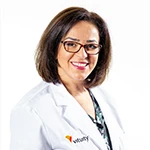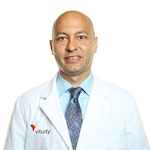As the population ages, the incidence of stroke and other neurological emergencies is on the rise. Hospitals that meet the growing need for acute neurology care provide an invaluable service to their communities.
One way hospitals can build strong stroke treatment programs is to pursue accreditation as a Joint Commission-certified stroke center. In this exclusive interview, Vituity's Vice Presidents of Neurology, Arbi Ohanian, MD, and Yafa Minazad, DO, talk about the accreditation process and how Vituity helps our hospital clients achieve certification.
What does it mean to become a certified stroke center?
Ohanian: The Joint Commission offers several stroke certification programs, but the two that most hospitals focus on are Primary Stroke Center and Comprehensive Stroke Center.
Primary Stroke Center accreditation certifies that a hospital demonstrates the competencies necessary to treat acute stroke in the ED and also to manage stroke patients appropriately once they're admitted to the hospital.
Comprehensive Stroke Centers do all of that plus more advanced treatments like coiling, clipping, and interventional procedures.
Today, there are 1,200 to 1,500 Primary Stroke Centers and 150 to 200 Comprehensive Stroke Centers.
Why should hospitals consider stroke center certification?
Ohanian: Until recently, there were no real treatments for acute stroke. However, there are now extremely effective treatments, and they have quickly become the standard of care. Today, stroke patients who come to the ED unable to speak and weak on one side sometimes walk out completely normal after receiving care from a trained specialist.
Performing these high-acuity treatments and procedures can be quite profitable for the hospital. But even more importantly, there's an opportunity to provide an invaluable service to the community.
What's the biggest barrier to stroke certification?
Ohanian: Unfortunately, there's a huge shortage of neurologists in the United States. And most practicing neurologists prefer to work in outpatient settings. So hospitals pursuing stroke center certification often don't have access to the neurology expertise necessary to develop their stroke programs to Joint Commission standards.
What's involved in becoming a stroke center, and how can Vituity help?
Minazad: Vituity provides hospitals with the most important component of stroke care: neurologists with expertise to care for patients with stroke and other neurological emergencies. We assist the hospital with physician and advanced provider recruitment as needed. And we can also use teleneurology to fill any gaps in coverage.
The second way we help is to provide leadership. At Vituity, we have a committee of at least six fellowship-trained stroke neurologists. We often bring these subspecialists in to serve as medical directors during the accreditation process.
These physicians have all been through stroke center accreditation at other facilities, so they have a road map to move the process forward. They know exactly how to work with the stroke coordinator, what order sets to create, and what data to gather in order to meet the Joint Commission's standards.
In addition, Vituity sends its in-house consultants to hospitals seeking accreditation. These consultants perform operational assessments to find the most cost-effective way of setting up the stroke program. Consultants also work with the medical staff on process improvement and help to integrate the neurology service into the hospital's operations.
Does this approach work for all hospitals? Is it feasible for a small community hospital with limited resources?
Ohanian: Yes, we work with hospitals of all sizes. Every hospital is unique, so we always develop the program to fit the needs of the hospital.
For example, many hospitals want to offer interventional procedures, and we can help them to set up that service. In some cases, bringing interventionalists in-house isn't really feasible, so we look at ways to assess patients quickly and expedite transfers.
Another example: some hospitals have access to local neurology coverage. In these cases, we work with the neurologists to develop the program. And at other hospitals, Vituity neurologists provide all of the services.
Whatever the hospital needs, we tailor our approach to help them achieve accreditation.
You mentioned that the neurologist shortage is a major barrier to certification. How do you provide neurology coverage in areas with few neurologists?
Minazad: Telehealth has been a game changer for neurology care, because it allows our neurologists to deliver fast and comprehensive care to patients in a timely manner using technology.
At Vituity, we've had a lot of success using teleneurology to fill gaps in specialist coverage. Some hospitals use it 24-7 while others only need it nights and weekends. It's especially cost-effective for smaller hospitals that don't see enough stroke patients to justify keeping a neurologist on call.
Some hospitals are initially skeptical about teleneurology, because they believe doctors will deliver better stroke care face-to-face. But the truth is, the latest generation of telehealth platforms — including the one we use at Vituity — are incredibly powerful and effective.
With our current platform, the teleneurologist has complete control of the camera in the patient's room. They can look around and talk to the patient, family, and ED team. They can focus close-up on the patient's pupils and zoom out to check gross movement and muscle strength.
In other words, teleneurology empowers the provider to do everything needed in order to diagnose stroke and recommend treatments. It's really amazing how far the technology has come and the impact it has on patient care.
When it comes to helping hospitals achieve stroke center accreditation, do you have any recent success stories?
Minazad: Many! All of our current acute neurology clients are either accredited or working toward accreditation, so there's a lot to celebrate.
For example, we had a great experience today with a community hospital that's working toward becoming a Primary Stroke Center. It's in the final stages of accreditation and requested a teleneurology consult to demonstrate the process to administrators and EMS personnel. All of them came into the ED to talk to us, and we showed them how the camera works. It was a lot of fun, and the stakeholders were very impressed.
How long does the accreditation process take?
Ohanian: Hospitals can achieve Primary Stroke Center certification within a year if they have a good strategy in place. At minimum, they need to show at least three months of data. And of course, most places need additional time to build up their processes.
For a stand-alone hospital, a year is a reasonable expectation for primary certification. At Vituity, we can often achieve it faster if we're working with multiple hospitals in the same system or company.
Thanks so much for talking with us today. Any final thoughts for hospitals working toward stroke center certification?
Ohanian: If you're considering stroke center certification, Vituity Acute Neurology is here to help. When we partner with a hospital, we're totally invested in its success. So if we see something missing — an issue with order sets, a gap in clinical education — we make an effort to close it.
We also help with issues outside our neurology wheelhouse or contractual obligations, because we care about the overall health of the program. We make it our business to make sure our hospitals succeed.
Interested in having Vituity put your hospital on the fast track to stroke center accreditation? To learn more, visit our acute neurology page.
Originally published Nov. 13, 2018.
























